Susan Wiggs's Blog, page 17
September 9, 2016
announcing….THE APPLE ORCHARD :: The Motion Picture
IT’S HAPPENING. The Apple Orchard is going to be a movie. Whee! Tess, Dominic, Isabel, Annelise, Magnus…they’re all coming to life. Watch this space for updates. In the meantime, play casting director and tell us who you picture in these roles.
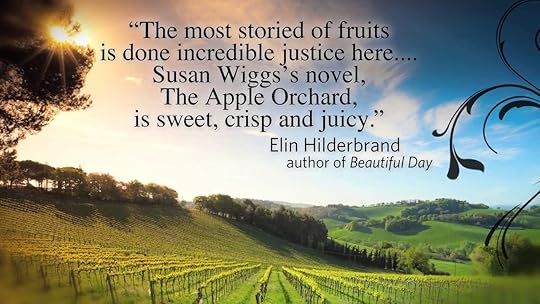
From Publishers Weekly:
The Hallmark Channel has optioned TV rights to The Apple Orchard (Mira), bestseller Susan Wiggs’s 2013 novel. Lucy Stille at APA and Meg Ruley at the Jane Rotrosen Agency brokered the agreement for the book, which, Ruley said, follows two sisters raised separately “who meet for the first time during a crisis at the family’s Sonoma wine-country estate.”
My Bella Vista Pinterest boards are filled with visuals I collected while writing The Apple Orchard and its companion volume, The Beekeeper’s Ball. And yes, I have a third book in mind, but it’s not written yet. Stay tuned! Don’t touch that dial!
The post announcing….THE APPLE ORCHARD :: The Motion Picture appeared first on SusanWiggs.
September 8, 2016
I didn’t personally bend your book
I appreciate each and every reader who takes the time to post a review of my books. But every once in awhile, there’s one that has me scratching my head. From my editor, whom I love like my long-lost son:

He spotted a one-star gripe that reads simply ‘Product has been bent!’. Rushing to my defense, he adds, “…which I have voted down as Not Helpful. SANDY G, DO YOU THINK THAT SUSAN WIGGS HERSELF BENT YOUR ‘PRODUCT’? BECAUSE I’M PRETTY FREAKING SURE THAT’S NOT THE CASE.”
The post I didn’t personally bend your book appeared first on SusanWiggs.
September 5, 2016
switching genres
Publishers Weekly has been my bible for 30 years. I sold my first novel 30 years ago this summer, in fact. Since Passing Through Paradise is being reissued this month, I thought I’d share a behind-the-scenes glimpse of the process of switching genres from historical romance to general fiction. The original interview can be found in PW’s archives. Thank you to Suzanne Fox!
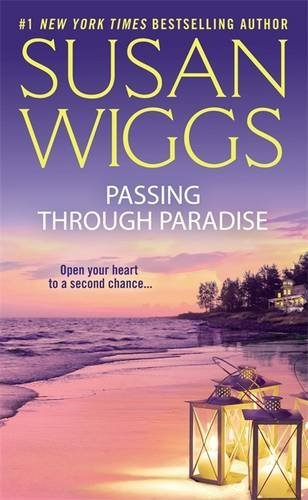
PW Talks with Susan Wiggs
by Suzanne Fox |
Jan 28, 2002
PW: Passing Through Paradise is only your second contemporary novel in a career built on historical romances. What drew you to this new area?
SW: It felt like a natural transition. I’ve always loved writing emotionally rich, character-driven novels that explore the way people fall in love and deal with life’s triumphs and tragedies. I enjoy writing the contemporary and historical books equally, though perhaps “enjoy” is the wrong word. Writing is a struggle no matter what the genre.
PW: Why have you chosen to work with Warner for your contemporary novels and Mira for your historicals?
SW: In both cases, I have been fortunate enough to find editors who appreciated my voice and saw the commercial potential in what I am doing. Mira publishes my historicals and has a fantastic distribution system, but Warner has been incredibly receptive to my contemporary novels and has packaged them to appeal both to a core romance audience and to readers of women’s fiction.
PW: Some might classify your latest as women’s fiction rather than mainstream romance. How do you see the distinction between the two, and which category do you think your book belongs to?
SW: This book is women’s fiction. In women’s fiction, the canvas moves beyond the falling-in-love stage of a relationship, which is the terrain of pure romances, to address all of the loves that fill a woman’s life—her relationships with parents, children, siblings, friends…: everyone who plays a part in her journey.
PW: Passing Through Paradise is also infused with a stronger sense of place than one sees in the typical romance novel.
SW: In all my novels, a sense of place—not just geographic but social—is a critical element. I have always been drawn to the novels of Edith Wharton, among others, where social dynamics are crucial. Wharton’s class consciousness fascinates me, and some of the tension in my books stems from that. For example, Passing Through Paradise contrasts the upper-crust family of the heroine’s first husband, with the working class background of her new romantic interest.
PW: Wharton is a writer drawn to bleak conclusions, while your own work is undeniably optimistic.
SW: As a reader, I was often frustrated by Wharton’s ambiguous endings; as a writer, I gravitate toward empowering and uplifting conclusions. That’s not just a response to my chosen genres but also a reflection of my views about life. I love my life, my family and my friends, and I’m drawn to “relationship” novels because of their affirming focus on the power of love to heal wounds and transform lives.
PW: What inspired Passing Through Paradise?
SW: The themes of personal integrity, sexual awakening, and emotional healing in the book have been percolating for a while. I’d been wanting to write about a woman forced to choose between making a damning disclosure to save her own skin, or staying mum and hoping for the best. Like all of my novels, there is a strong, underlying mythic structure to the story.
PW: Your female protagonist is a writer, a career often regarded as problematic for novelists. How did this element evolve?
SW: I made Sandra a writer because it was a good match with the book’s theme of the consequences of keeping secrets from the people you love. What’s a writer, after all, but a big fat liar who tries to prove a greater truth?
PW: Is the portrayal autobiographical?
SW: I had fun putting some of my own quirks into my heroine’s writing process: the fountain pen with peacock-blue ink, the zany journal entries, the endless lists on Post-it notes. The major difference is that my books are available in bookstores, airports and discount stores while Sandra’s young adult novels are banned. I had to imagine what it would do to a writer to be told, “We don’t think people should have access to your books.”
PW: What’s currently in the works?
SW: Mira is reissuing a personal favorite, The Lightkeeper, followed by a historical romance entitled Enchanted Afternoon. I’m also finishing up another contemporary novel, Home Before Dark, about the lives and loves of two sisters in Texas.
A version of this article appeared in the 01/28/2002 issue of Publishers Weekly under the headline: PW Talks with Susan Wiggs
The post switching genres appeared first on SusanWiggs.
August 21, 2016
into the sugarhouse
When I was a little girl, my Uncle Tommy used to take me, along with my brother and sister, to the sugarhouse on his property high in the snow-clad hills. There, the maple trees grew wild, and we could commute back to the house on a toboggan that fit all three kids in a row, crash landing more often than not. 
My uncle was deaf from birth, and he always felt most at home in nature, where the communication did not demand words. He loved working the land year round, raising game birds, Irish setters, cattle and crops–but the tail end of winter was a slack time, when everything lies dormant.
Or so we think. People in sugarbush country know that the earth is just waking up from the long cold winter. In late February or March, the daytime temperature creeps above freezing, and the thaw begins. Deep within the heart of the sugar maple, the sap comes alive and runs–at first a trickle, followed by a steady flow, and when the conditions are just right, almost a gush. 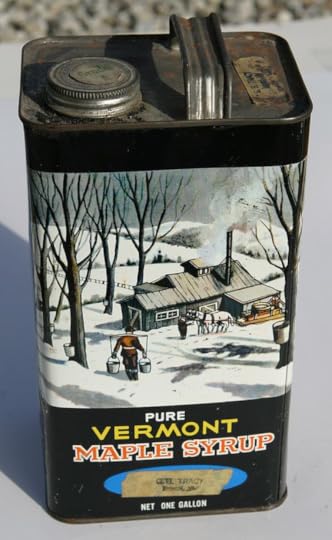
I used to get in trouble for climbing the maple trees, because my clothes would get sticky with sap–but tree climbing never bothered my uncle. He collected the sap in the old way, by drilling a spile (hollow metal spout) into the tree and hanging a bucket to catch the drips. It was probably cold, muddy, miserable work, but I don’t remember that part. I just remember riding through the woods on a stone boat behind the tractor, bringing the tanks of collected sap to the sugarhouse.
That was where the magic happened. A roaring woodfire under the big evaporator pan performed an act of sweet alchemy, transforming the clear, sweetish, watery substance into gorgeous amber maple syrup, bottled in tin quart drums labeled Tee Jay Farms. When the temperature reached its zenith–219F–my uncle would treat us to “sugar on snow”–a splash of syrup on a mound of fresh snow. It would harden instantly into the purest candy you can imagine.
The flavor of maple brings memories of family favorites–iced maple bars, fried doughboys, oatmeal swimming in syrup and maple creme brulee. And memory, any writer will tell you, gives rise to inspiration. I imagined a woman far from home, nearly destroyed by disaster, coming home to a place like Switchback, Vermont, to reconnect, to remember, and ultimately to heal.
My childhood took a turn when my father’s career sent the whole family to live in far-flung places overseas. Those early memories, then, are gilded by nostalgia. In my writing, it’s the backdrop to the deepest and strongest themes–family, friendship, romance, hope and healing. It’s the terrain of the Lakeshore Chronicles, and now Family Tree.
I’ve spent summers on the beaches of Rhode Island, renting a clapboard house with terrible insulation, a faulty propane tank and a dead-on view of Narragansett Bay. Easy friendships revolved around food–lobster rolls from Aunt Carrie’s, clam bakes on the beach, beer and awful music at Schiller’s bar. Readers of Summer by the Sea and Passing Through Paradise will recognize the salty, scenic locale in my fiction.
Somerville, Massachusetts was my home while I was in graduate school. My landlady was a fiery Irish American woman serving a term in the statehouse, and the neighborhood teemed with Italian bakeries and delis–thick, square cuts of pizza, fresh cannoli stuffed with cream, and fried scrod served in paper cones. Steve’s Ice Cream was my decadent splurge. On a chilled countertop, they kneaded the flavorings right into the heart of the scoop. While living in a postage-stamp-sized apartment with a golden retriever and a manual Olivetti typewriter, I had the kind of creative energy only a twenty-year-old possesses. I held down a teaching job, finished my master’s degree, learned to cook gourmet meals on two burners, knitted Fair Isle sweaters…and I wrote my first novel.
A writer’s path is filled with unexpected twists and turns, much like a well-plotted novel. Yet ultimately, we return to the places of our heart–a seaside village, an urban enclave, a moment in time, or a mountaintop clad in sugar maples, with the sugarhouse in the center, maple-scented steam rising from the roof vents, and a warm fire burning deep into the night.
The post into the sugarhouse appeared first on SusanWiggs.
August 3, 2016
back to basics :: from my writer’s notebook
When I’m in the throes of rewriting a book (and wondering why I didn’t write it right the first time), I go back to basics. My study is strewn with lecture notes on writing workshops I’ve attended, dating all the way back to 1986, the year I sold my first novel.
One of my favorite writing teachers is a screenwriting expert–Michael Hauge. If you ever get a chance to see him in action, run don’t walk! My notes include asides about Family Tree. Doing this always makes the story sound so pedestrian! But it’s a good exercise. It’s lengthy so I’ll post it in parts over the next few days. Here goes:
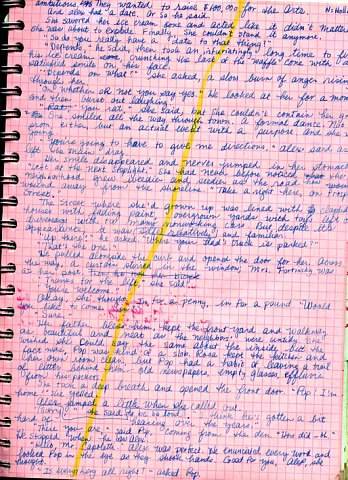
first draft – not a pretty sight
The hero is the story’s protagonist. It’s a generic term so the gender pronoun doesn’t matter. Briefly, the hero is the one whose goal drives the story. His goal is the finish line the reader wants to see the hero reach.
The ultimate goal of a story (fiction, narrative nonfiction or memoir, film, drama) is to elicit emotion. This is achieved by creating a character who has a powerful desire, facing a conflict that keeps her from fulfilling that desire.
A story’s first audience–agent, editor, first reader, etc.–wants to know how this story is going to sell. Who are we rooting for? The most consistent problem with stories is that they are overcomplicated. The solution? Make it simpler. How? By understanding plot structure.
A story exists on two levels, the outer (visible) journey and the inner (emotional) journey or arc of growth (or deterioration/failure).
In the outer journey, the desire is visible. It’s a journey of achievement or accomplishment. What tangible thing does the hero want? It should be something the reader can see. (In Family Tree, Annie wants to reclaim the life that was derailed after a horrific accident.) There is a visible finish line, and the hero’s outer motivation is also visible.
The conflict must also be visible. (Again in FT, we see that everything Annie wants to reclaim has been ripped away from her.)
There are 4 general types of goal/conflict setups in most commercial stories (including novels, narrative nonfiction and films).
1. To win – a sports contest (Rocky), the love of another character (most romances)
2. To stop something from happening –most thrillers seek to keep a disaster at bay
3. To escape–character must get out of a bad situation (The Count of Monte Cristo, anything with “escape” in the title)
4. To retreat–quest stories in which the character must go and get something and return with it.
Michael calls these the 4 basic Hollywood goals. And you should believe him. He’s very smart about these things.
This is the outer plot. There is also a second level underneath the visible plot–the inner journey. A journey of fulfillment and/or transformation.
The love story is a great tool for developing a character arc.
Who is your character and what does he desire? What sort of plot will your story follow?
(In Family Tree, Annie Rush is the producer of a successful cooking show who faces overwhelming odds following an accident. Her journey brings her face-to-face with the past she left behind in Switchback, Vermont–a past that includes the town bad-boy-turned-good, aka the path not taken.)
Michael created a chart showing a 6-stage plot structure in 3 acts. There are 5 key turning points in a story. If I make my revision goal today, I’ll post his general structure for the OUTER journey.
NOTE TO READERS WHO PREORDERED FAMILY TREE! You are qualified to enter to win a $100 gift card because you were an angel and you preordered the book!
HOW TO ENTER
Pre-order FAMILY TREE (from any of the 3 links below) Email a photo of the receipt, your FULL NAME, PERMANENT ADDRESS, EMAIL ADDRESS, PHONE NUMBER, and the NAME AND LOCATION OF WHERE THE PRODUCT WAS PURCHASED.
please send to SusanmWiggs @ gmail.com
The entrant must retain their original receipt of purchase.
http://www.eagleharborbooks.com/pre-ordered-signed-first-ed…
http://www.barnesandnoble.com/w/family-tree-sus…/1122784942…
http://www.booksamillion.com/p/Family-Tree…/…/9780062642899…
Winner will be randomly picked August 9th 2016 before midnight PST.

The post back to basics :: from my writer’s notebook appeared first on SusanWiggs.
July 26, 2016
revisions :: writing it right
I’m working on revisions for a book I recently finished. A lot of writers despise this part of the process. We scratch our heads, wondering why we didn’t write it right the first time. Well, because…I don’t know why. A first draft just comes out the way it does. I tell myself revision is re-vision. I get a chance to apply a new vision to the work. To re-imagine it. That’s not so bad, right?
Today’s wisdom is from the master, Dr. Seuss.
So the writer who breeds more words than he needs, is making a chore for the reader who reads.
–Dr. Seuss
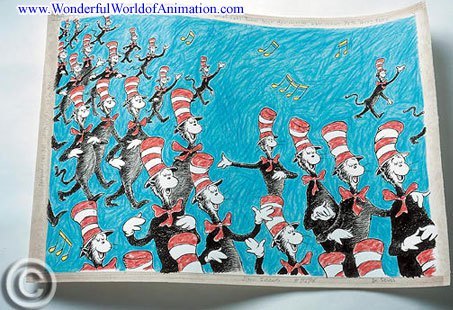
Singing Cats (endpaper from Cat in the Hat songbook)
Dr. Seuss is my hero for a lot of reasons. The perfect quote above is one of those reasons. Also, I collect his art. I admire his career. Did you know, he never took an advance from a publisher? Which probably makes him a hero to publishers as well…
#writing #revisions #Dr.Seuss
The post revisions :: writing it right appeared first on SusanWiggs.
June 29, 2016
just a friendly reminder…
…never to forget your anniversary.
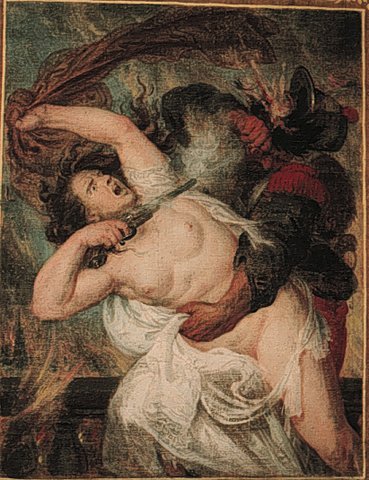 it won’t go well for you
it won’t go well for youThe post just a friendly reminder… appeared first on SusanWiggs.
June 21, 2016
romance in the neighborhood
My anniversary is coming up, so I thought I’d revisit and update a post for you. This was a fun assignment from my local chamber of commerce. I had to come up with ten romantic things to do in my town. My overachiever tendencies came out, and I listed 11. Comment below–what’s romantic about your town?



11 Most Romantic Things To Do On Bainbridge Island

compiled by Susan Wiggs
1. Watch the sunrise from Fay Bainbridge State Park.
2. Breakfast options- Café Nola -white table cloths, good coffee, luxurious food. Or if it’s a beautiful day, grab some pull-aparts from Bainbridge Bakers and take them down to Waterfront Park and share. If it’s a Saturday, buy fresh berries at the Farmers Market.
3. Recreation! Rent a two-person kayak and paddle around, even out to Blake Island if you’re feeling brave. Or get a Laser sailboat or dinghy and explore; you’ll probably encounter sea lions. Seeing wildlife up close together is inherently romantic. Landlubbers can bike along the south end, taking in Fort Ward State Park to watch the boats go by. Romantic walks depend on your mood and fitness level: It’s an easy beach walk from Lynwood Center toward Point White and back, offering matchless views of Mount Rainier and a bird-watcher’s dream at the estuary. Or you could hike a secluded woodland trail, like Peters Trail and not run into a soul. If you have access to a horse, go for a ride in the Grand Forest . (Good luck with that, sez Jay.) For the athletes-try a round of golf or tennis at Meadowmeer followed by a nice drink on the deck.
4. Get a picnic lunch from the New Rose Café at Bainbridge Gardens , or at Hitchcock Deli take-out and share at one of the shady picnic tables at Strawberry Hill Park.
5. Go for a stroll in the Bloedel Reserve . A really long stroll, and don’t take any shortcuts. Nobody will think less of you if you engage in naughty role play in the main house or the Japanese tea house. And do not ask me how I know this.
6. Stop in at Bainbridge Gardens because after Bloedel, you are going to want to bring home a fancy plant like Nightshade. Then go shopping along Winslow Way-don’t miss the original jewelry creations and vintage collection at Gilbert Thomas. At Eagle Harbor Book Company , you’ll find signed books from every one of the island’s 13,447 (and counting) famous authors.
7. Get dual massages at Spruce Day Spa.
8. Most romantic restaurant, bar none: A corner booth at Restaurant Marche. Lovely setting in a historic building, gorgeous food and wonderful service.
9. Catch an indy film at the historic Lynwood Theatre and afterwards, stop in at the Beach House for coffee or a nightcap.
10. Stargazing at Battle Point is a must.
11. Romantic places to spend the night abound. Our favorite, of course, is Point White Guest House.
The post romance in the neighborhood appeared first on SusanWiggs.
June 10, 2016
Every great love story has a beginning.
From #1 New York Times bestselling author Susan Wiggs comes a wonderful companion story to her unforgettable novel Family Tree.
Meet Annie Rush in THE KEY INGREDIENT, my new short story set in Vermont. It’s available exclusively as an ebook, and is the prequel to my new novel FAMILY TREE, on sale 8/9. Pre-order THE KEY INGREDIENT from your favorite ebook retailer – it’s on sale 6/14 – to get a sneak peek at FAMILY TREE!
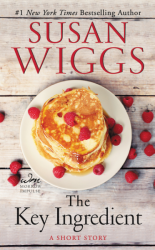 Every great love story has a beginning…(and who doesn’t love pancakes?)
Every great love story has a beginning…(and who doesn’t love pancakes?)Every great love story has a beginning. Annie Rush’s started at a food cart in a vibrant city park. Annie, then a film student, came across a ruggedly handsome, charismatic chef serving up gourmet street food to an ever-growing clientele lining up for his creations. Together, Annie and Martin Harlow conceived The Key Ingredient, a cooking show featuring Martin as the star while Annie handles production.
As they travel to Annie’s Vermont hometown to film their pilot episode, she realizes that she might want to create more than television magic with Martin. But does he feel the same way? The weather is miserable, their shoot is a disaster, and the maple syrup just isn’t flowing. While Annie tries to cling to her vision for their show, she can’t help but wonder if she could be as unlucky in work as she is in love. Is she always destined to stay behind the scenes?
Just as some recipes only come together at the last minute with the addition of a key ingredient, sometimes a single moment can change everything—turning Annie’s life into a cornucopia of good fortune, the feast of her dreams.
The Key Ingredient – Susan Wiggs – E-book – HarperCollins US
www.harpercollins.com
The post Every great love story has a beginning. appeared first on SusanWiggs.
parenting tip
Here’s how to 1) have a successful pool party and 2) embarrass your teenager IN ONE SIMPLE STEP! #parentingtips #teenagers #summerfun
Print out the list of rules below. Then make a martini, put on the headphones, kick back and enjoy.
House Rules
Polite language only, please. Swearing makes Susan’s ears bleed. She’s like your grandma, only meaner. If we catch you swearing, you have to wear Clara’s tutu.
No adjusting the music or touching the speaker, especially if you’re wet. Whenever you hear Carter’s favorite song by Katy Perry, you have to stop what you’re doing and dance.
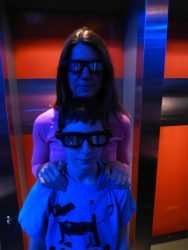 Don’t mess with her.
Don’t mess with her.Use your phone only to take photos and to check in with your parents. If you play a game on your phone, we will take an embarrassing picture of you and post it.
If you’re wet, stay outside. We mean wet feet, clothes, hair, nose hairs, everything. There is a Honey Bucket for wet people to use.
Go outside anyway–the beach, the corner village, the trails.
 sunrise
sunriseDoors stay closed. No running through the house. If you’ve seen what Barkis does when people run, you’ll understand.
There is a special place in hell for people who chase Lenny.
 Though he be but small, he is fierce.
Though he be but small, he is fierce.If you overuse the word “like,” you have to, like, wear the mosquito hat until, like, someone, like, says it more than you.
After 9pm, it’s quiet time. Don’t go near the guest house. There are zombies staying there and they don’t like to be disturbed.
No movies naughtier than PG-13. If you argue over which movie to watch, then the movie will be Bambi. 
Be safe about fire. We like barbecued meat, but teenagers tend to be too tough to eat.
 Beware of pirates in the neighborhood.
Beware of pirates in the neighborhood.Peeing in the hot tub or pool will activate the sensor dye and everyone will know you did it.
You can play with the Airhead, paddle boards and kayak in the Sound, but do NOT let them scrape bottom–especially the Airhead. A floatation device is mandatory. On the paddleboard, use the ankle strap because that’s the floatation device.
 Safety first.
Safety first.You get one drink cup and one paper plate. Put your name on them. If you lose your cup, you have to drink out of Carter’s glass.
Helmets are mandatory. Maybe not for swimming unless you’re super clumsy.
Cleanup happens before the movie. Cleanup means all pool toys, towels, S’mores stuff, dishes, drink stuff, leftover food, extra clothes, dead rats, ashes of former teachers.
Final cleanup happens before breakfast, and you need to be finished with all your stuff in the car by 9:30am.
The post parenting tip appeared first on SusanWiggs.



